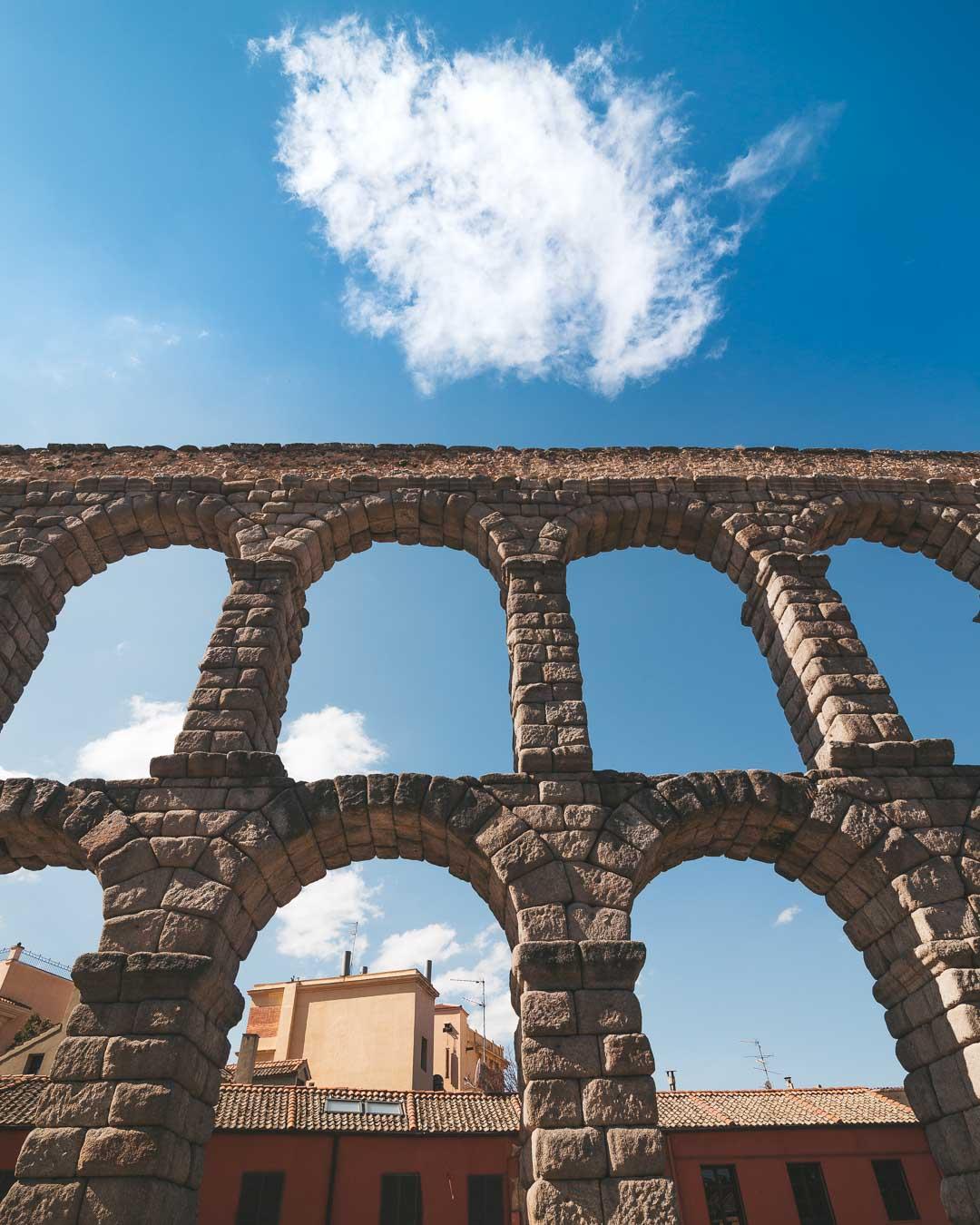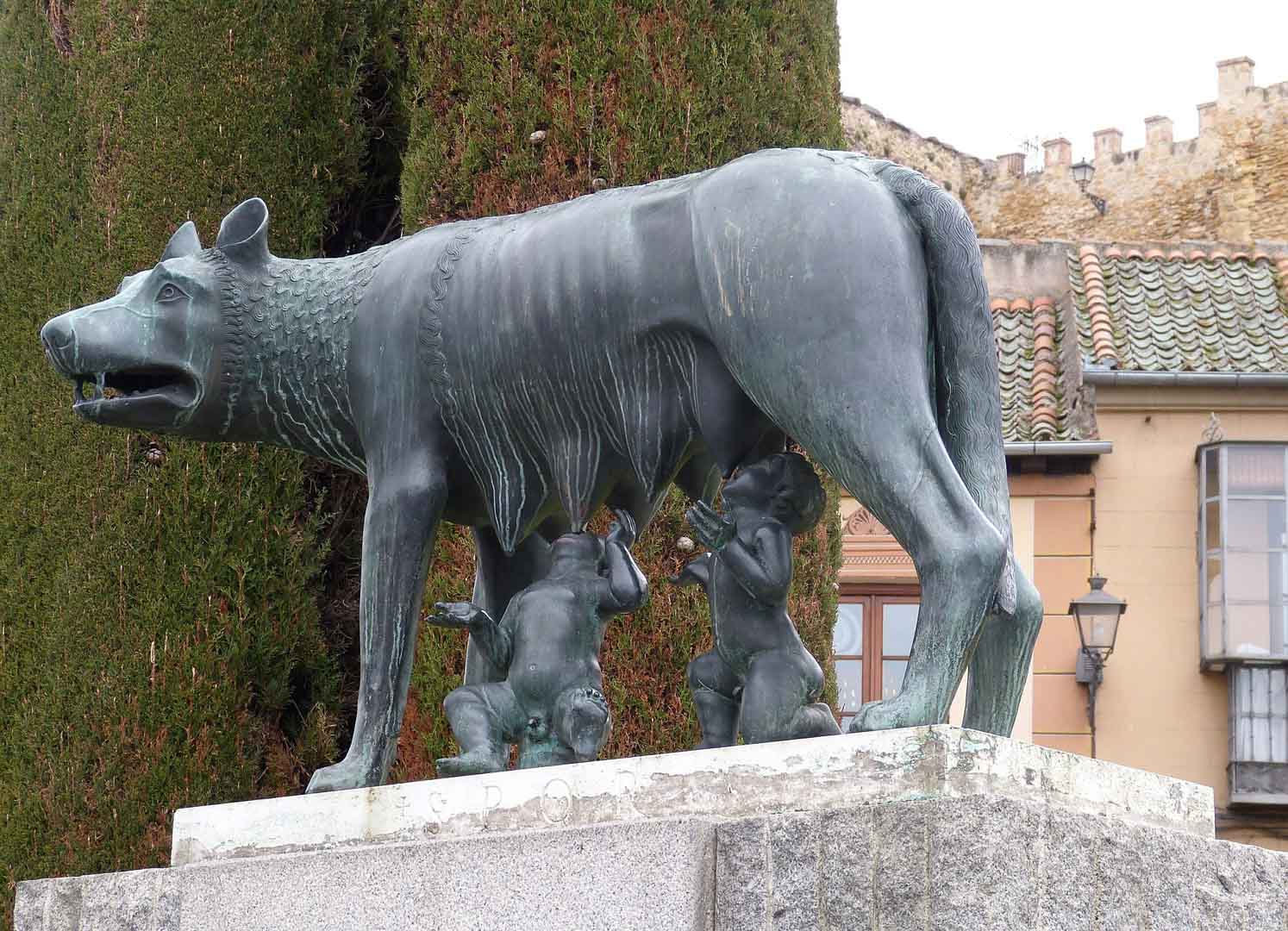Acueducto de Segovia – Visiting the Roman Aqueduct in Segovia, Spain
The Acueducto de Segovia is probably the most famous monument in Segovia. Picture this: a massive stone aqueduct, built by the Romans in the 1st century, crossing the valley in the center of the city, still standing after 2,000 years.
Sounds epic, right?
Well, let’s visit!

The Aqueduct de Segovia is the most impressive Roman structure in Spain, and it was listed as a World Heritage Site by the UNESCO in 1985, together with the Old City of Segovia. If you’re coming to Segovia from Madrid by train or by bus, it’s the first thing you’ll see in the city.

In this travel guide about the Acueducto of Segovia in Segovia, Spain, you’ll find in the table of contents below everything that we’ll see, from visiting the aqueduct & learning how it works, to quick facts & the legend around it. Simply click on the table to expand it, then click on any part you’d like to jump to.
TABLE OF CONTENTS
- Where is the Acueducto de Segovia?
- Aqueduct of Segovia Facts
- Visiting The Aqueduct de Segovia
- How Does the Aqueduct de Segovia Work?
- The Legend Around the Aqueduct in Segovia
- Segovia Aqueduct Tickets
- Acueducto de Segovia Opening Hours
- How to Get to the Roman Aqueduct of Segovia
- Where to Stay near the Aqueduct in Segovia
- Visit Spain
Where is the Acueducto de Segovia?
The Aqueduct of Segovia is located in the city of Segovia, Spain, north of Madrid.
The aqueduct is in the north part of Segovia, in the old town, next to the San Millan neighborhood. It’s a short 10 minutes walk from the famous Segovia Cathedral.

Aqueduct of Segovia Facts
Are you fond of facts? I know I am! I love learning more about a place and its history with some quick & interesting facts, so I’ve gathered a few about the Segovia Roman Aqueduct for you:
- the aqueduct is almost 2,000 years old
- it was built around 112 AD, under orders of Emperor Domitian
- the roman aqueduct is 28.5 meters high (93 feet), and it spans over 818 meters (1/2 a mile)
- there are in total 167 arches
- the aqueduct channel is 15km long (9 miles): from the mountains in the South East to the Alcazar in the North West
- this one blew my mind: no cement/mortar was used to built the aqueduct. The granite blocks are simply put one on top of the other.
- around 25.000 granite blocks were used to built the aqueduct

Visiting The Aqueduct de Segovia
After exploring the Segovia Cathedral for the first part of the day, and stuffing myself with incredible pastries from one of the local pastry shops, I was ready to continue my exploration of Segovia.
Before visiting the Alcazar de Segovia, the famous castle up north, I made my way to the center of the city, to see another marvel of architecture, the Roman Aqueduct of Segovia.

I arrived from the north, and reached the Postigo del Consuelo (gate of comfort), the southern gate of the historical city. I crossed the gate, and was granted an incredible view over the aqueduct.

From the heights of the murals, you see the massive aqueduct crossing the valley, with the gigantic double stone arches. As you can see on the picture below, the Aqueduct of Segovia is a rather famous monument in Spain, and it attracts a lot of visitors.
For this reason, if you want to take the best photos of the aqueduct, or if you want to experience it without the crowds, I recommend waking up early and going there for sunrise (looking for the best itinerary to see Segovia? Click here: Best Segovia Itinerary).

Next to the south gate, there are stairs that will lead you down to the main square, where you’ll be able to walk under the aqueduct.

The best place to behold the magnificent sight that is the aqueduct is on the Plaza del Azoguejo, which is the main square below the aqueduct.
This is where the aqueduct is the highest, reaching 28.5 meters (93 feet) with the double arches.
From down there, I found myself wondering how the hell did the Romans build such a thing, without even using mortar!

If you cross the square, you’ll see another flight of stairs, to go up on the other side of the valley. If you keep walking for a while, you’ll soon reach the part where the Acueducto de Segovia makes a turn.
You can see the bend from the sky on the photo below:

Right next to the aqueduct, on the Plaza Oriental, you’ll find the Loba Capitolina (Capitoline Wolf), a replica of the famous roman sculpture.

Of course, due to its height, the aqueduct is visible from a lot of different spots in the city. Get lost in the streets of Segovia and you’ll be rewarded with new views of the aqueduct!

If you post your photos of the Acueducto de Segovia on Instagram, tag them with #kevmrc so that we can see them!
How Does the Aqueduct de Segovia Work?
If you’re like me, you’re probably wondering: “but why the hell did the Romans build that thing?”.
Yes, good question, why?
The aqueduct was the Romans version of running water. It was used to transfer fresh water from the mountains straight to the city.
The aqueduct goes on a gentle slope (0,43%), and carries the water to the city.
If you’re interested in knowing exactly how an aqueduct work, check out this in-depth explanation here: How Aqueducts Work
Does the Segovia aqueduct still work?
No, it stopped being used in the mid-19th century.
The Legend Around the Aqueduct in Segovia
The Segovia Aqueduct is such an incredible structure that it’s hard to believe that it was built in the 1st century. To explain how this marvel of architecture was built, there is a local legend.
Legend has it that the aqueduct was built by no other than the Devil itself.

A local girl was carrying water all the way up to the city, and was getting tired; she made a pact with the Devil, offering him her soul if the water was carried home before dawn.
The Devil worked hard to built the aqueduct, but alas for him, dawn broke before he could lay the final stone, and he lost the girl soul.
If you look carefully, you’ll see the claws of the devil, holes in the stone of the aqueduct…
Segovia Aqueduct Tickets
You don’t have to pay to visit the Segovia Aqueduct.
The monument is in the middle of the city, and you can see it directly from the street.
Acueducto de Segovia Opening Hours
You can’t go inside or climb the aqueduct, so there are no opening hours.
Feel free to come at whatever time you want, you’ll be able to see the monument.

How to Get to the Roman Aqueduct of Segovia
You can either get to the aqueduct by car, or by train.
By car
Segovia is a perfect day trip from Madrid, and from other Spanish cities. You’ll find below the driving time from nearby cities:
From Madrid: 1h20 via highway, 1h40 without tolls
From Avila: 1h
From Salamanca: 2h
When you’ll reach Segovia, head to the center of the city. There are few parking lots available next to the castle, so you’re better off leaving the car in the city and walking to the castle.

By train
If you don’t have a car, you can get to Segovia by train from Madrid. There is a high-speed train that goes straight from Madrid to Segovia.
From: Madrid-Chamartin
To: Segovia AV
Duration: 30 minutes
Cost: 13,90€ (average price)
Book here: Renfe Train
You can also take the trains from other cities in Spain (Barcelona, Toledo, …), just click on the link above to see all options.
Where to Stay near the Aqueduct in Segovia
If you’re visiting the Acueducto de Segovia and Segovia, you have several options for where to stay. You’ll find below hotels depending on your travel style:
Budget: Hosteria Natura
Cheapest accommodation in Segovia, for around 30€ per night. It comes with private bathroom and free wifi.

This hostel has the best location, it’s right on the main square Plaza Mayor, and everything is within walking distance. There’s also A/C and heating in each room, for your comfort.
Best Prices: Hosteria Natura
Comfy: Hotel Spa La Casa Mudéjar
Very comfy rooms, with private bathroom, for around 65€ per night.

The two nice bonuses? It’s right next to the Cathedral, and there is a spa, the perfect place to go and relax after a long day of exploring Segovia!
Best Prices: Hotel Spa La Casa Mudéjar
Luxury: Hotel Infanta Isabel
If you’re looking for the perfect dreamy place to relax and enjoy your stay in Segovia, look no further.

The Hotel Infanta Isabel might very well be your favorite place in the city; luxurious hotel, with stunning rooms, and incredible beds. What about the location? Well, you’ll have a view on the Segovia Cathedral straight from your room!
Best Prices: Hotel Infanta Isabel
Visit Spain
Planning a trip to Segovia and Spain? You can find below several other articles about this wonderful part of the world to help you plan your trip:
Segovia Guides:
Alcazar de Segovia, the Walt Disney Castle in Segovia
Segovia Cathedral, Complete Guide to Visit
Spain Guides:
How to get from Madrid to Segovia by Train, Bus or Car
I hope you enjoy your trip to the Acueducto de Segovia and to Spain!
If you have any questions, let me know in the comments below, I always reply.
Travel Tools
Use any of our recommended links below to book your trip. You pay the same, and we earn a small fee; a great way to support us!
Pin this to Pinterest!
Enjoyed this guide? Then help a fellow traveler and pin it! They'll most definitely love you for it, 100% guarantee.



![Catedral de Avila – Visit the First Gothic Cathedral in Spain [2025 update]](https://www.kevmrc.com/wp-content/uploads/2016/12/catedral-de-avila-spain-20.jpg)